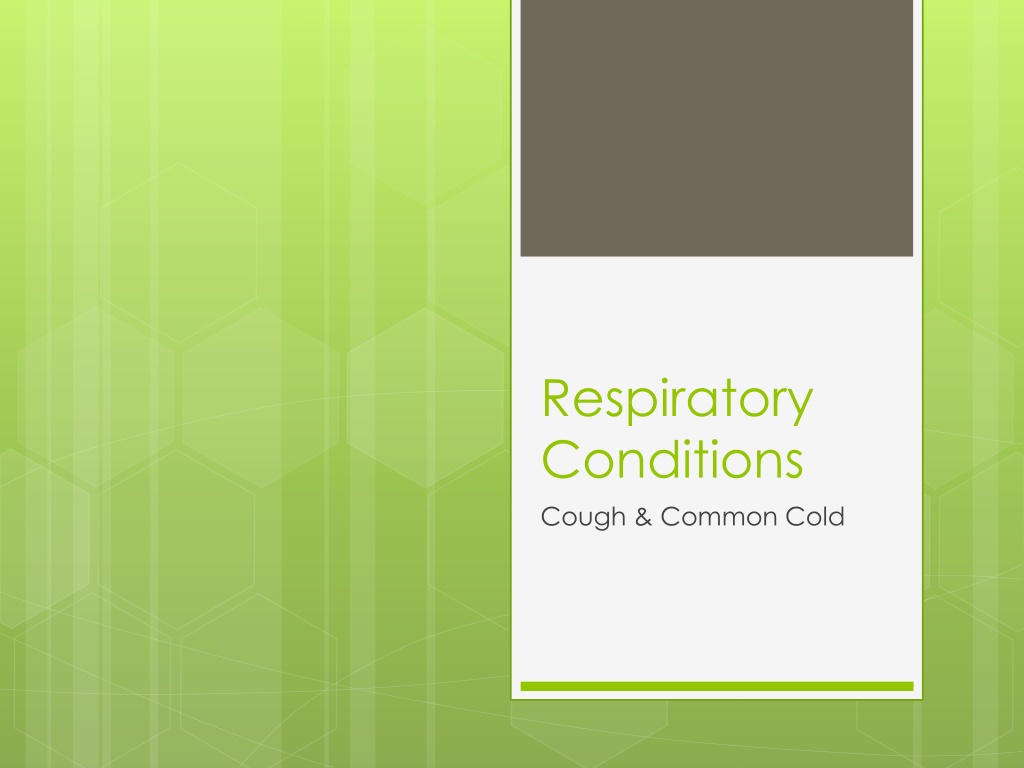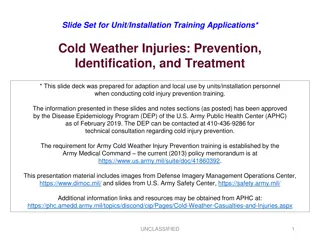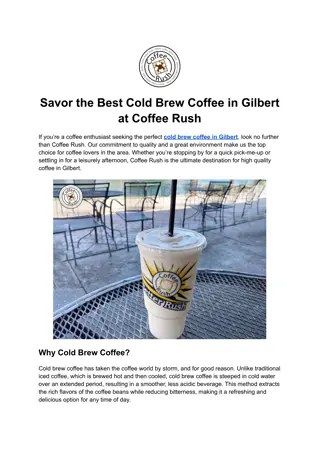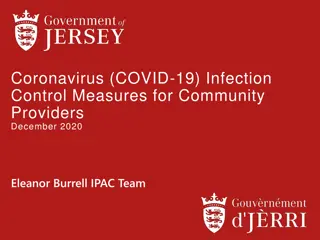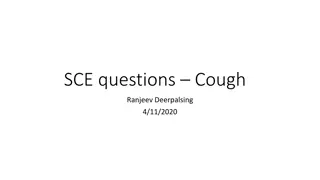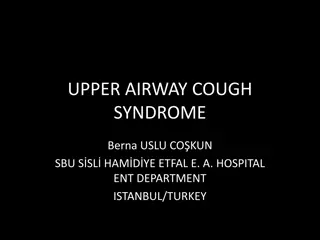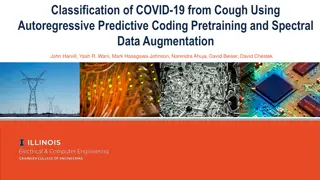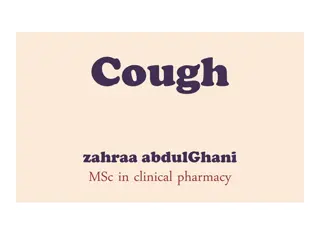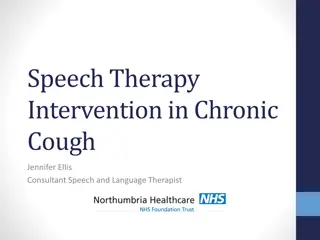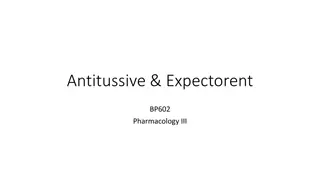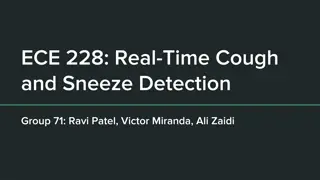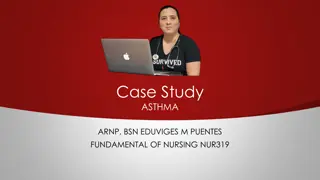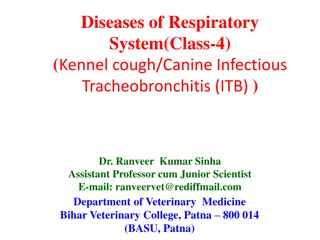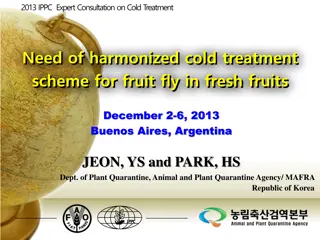Understanding Cough and Common Cold
Cough is a reflex action to clear airways, often caused by viral infections. It can be productive or non-productive, acute, sub-acute, or chronic. Assessing cough duration, nature, associated symptoms, drug-induced or condition-induced factors is crucial. Non-pharmacological treatments include steam inhalation, lozenges, and adequate hydration. Pharmacological treatments may involve expectorants for chesty cough and anti-tussives to suppress the cough reflex.
Download Presentation

Please find below an Image/Link to download the presentation.
The content on the website is provided AS IS for your information and personal use only. It may not be sold, licensed, or shared on other websites without obtaining consent from the author. Download presentation by click this link. If you encounter any issues during the download, it is possible that the publisher has removed the file from their server.
E N D
Presentation Transcript
Respiratory Conditions Cough & Common Cold
Cough Cough is a reflex action to remove secretions or foreign material from the airways. The majority of coughs presenting in the pharmacy will be caused by a viral upper respiratory tract infections (URTIs).
Types of cough according to nature: 1. Productive(wet or chesty); here ask about the color 2. Non-productive (dry or tight).
Types of cough according to duration: 1. Acute; which lasts < 3wks, mostly due to URT infection 2. Sub acute; between 3-8wks, which occurs after infection due to bronchial hyper-responsiveness 3. Chronic; which lasts > 8wks
Patient assessment of cough 1. Duration 2. Nature of Cough 3. Ass. Symptoms 4.Drug induced cough. 5.Conditions induced cough
WHEN TO REFER PATIENTS WITH COUGH?
Managements Non-pharmacological treatment 1. Drink warm water > 2L/day Steam inhalation Lozenges ( compose of eucalyptus, mint, soothing agents)
2. Pharmacological treatments: A- Expecturants: ex: guaifenesin guaicolate, ammonium salts. Used for productive (chesty) cough
B-Anti-tussive, act directly on the cough center to depress the cough reflex. Their effectiveness has been investigated in patients with acute and chronic cough ex: 1* codiene 2* dextromethorphan 3* butamirate citrate
Additional preparations Anti- Histamine have been included in cough remedies for decades. Their mechanism of action is thought to be through the anticholinergic-like drying action on the mucous membranes and not via histamine Ex: diphenhydramine
Common Cold Is a mixture of URT viral infection, self-limited but treatment is required. Transmitted primarily by direct contact with the pt. or through air droplets. Caused by rhinovirus (common) or adenovirus. symptomatic
Pt. assessment.: 1-Age 2- onset: common cold characterized by gradual onset 3- symptoms: mostly, common cold begins with sore throat followed by the other symptoms like sneezing, coughing, congestion, headache, etc 4- medical hx: conditions similar to common cold in symptoms
Managements A- non-pharmacological treatment; as mentioned in cough treatment B- pharmacological Due to the symptoms of common cold, the choose of medications will combination of - anti-H1 - sympathomimetics analgesic
Sympathomimetics agents: serve to constrict dilated blood vessels and swollen nasal mucosa, easing congestion and helping breathing. There are two dosage forms of sympathomimetics Systemic: phenylphrine, pseudoephedrine Topical: oxymetazoline, xylometazoline
Properties of sympathomimetics Topical drop suitable for DM, H.T patients Must be awarded about D-D interaction Duration of use, especially for topical Time of administration, because insomnia may happened Age of patient and select the suitable agent
Rhinitis: simply inflammation of the nasal lining. It is characterised by rhinorrhoea, nasal congestion, sneezing and itching. The majority of cases that present in a community pharmacy will be viral infection, colds or allergic rhinitis
Conditions to eliminate Rhinitis medicamentosa Rhinitis in pregnancy Foreign body insertion in nose
Management The key for controlling symptoms is by prevention. Especially for allergic rhinitis
Allergen avoidance Anti-H1, either sedative or non-sedative Sympathomimetics Topical corticosteroid
55 yrs. old male with hypertension, recently has common cold. The best treatment is pseudoephedrine (with combination) product.
Drug-drug interaction between sympathomimetics and beta blocker, TCA, MAO- I
Female on ACE-I drug, suffered from dry cough. The best treatment is dextromethorphan tab 1*3
